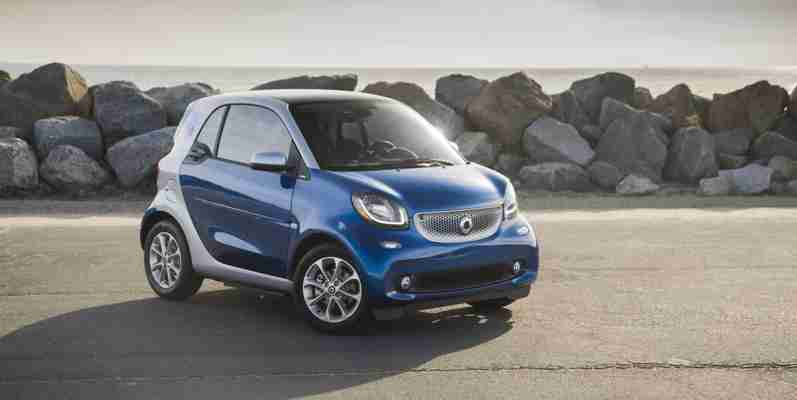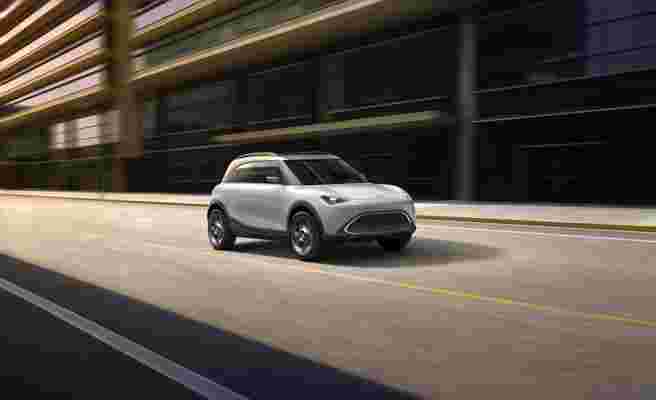Smart Cars Are Back From the Grave, Announcing Its Largest Small Car Yet
Smart Technology’s Impact on Driving?
Technology is constantly changing our daily experiences, including travelling. So, just what might car tech of the future look like?

The car industry has experienced its fair share of technological innovation. Car manufacturers are constantly trying to stay up to date with new innovations. At the rate that smart technology is advancing, companies have to work hard to avoid being left behind. Here, UK Volkswagen dealership, Vindis, investigate:
We’ve already seen huge advancements e.g. in-car Bluetooth systems, dash-cams, and key finders. But what’s next for the world of automotive tech? Smart technology predictions over the next few years are set to totally revolutionise the way people drive. These new ideas will focus on safer driving, easier driving, and adding more fun enhancements to your driving experience.
3D gesture technology
With technology we’ll be required to use our hands less and less. Imagine changing gears or winding down your car windows with a simple wave of your hand. Like magic, you will soon be able to control many elements of your vehicle with mere gestures. As well as being futuristic and fun, this tech is set to make driving easier and safer. Instead of jabbing at buttons on the radio, or being tempted to reach out for your phone, you will soon be able to point at the screen of your infotainment system to accept an incoming call — a simple solution that means you’ll never have to take your eyes off the road.
AR dashboard displays
The dashboards of our cars will be upgraded with augmented reality dashboards to provide our information. Giving your dashboard a video-game aesthetic, AR displays will show any information you need to know about the car itself. They will also give you other vital information about the road, such as how quickly you’re approaching another car, and how best to avoid collisions.
Inter-car communication
It’s become fairly common for cars to be connected to the internet. Soon however, these internet-enabled cars will have the ability to communicate with one another, transforming our driving experience. Communication between cars will help prevent collisions, with precision that human error has never before allowed us to achieve. Before a collision can occur, the car-to-car communication system will foresee the accident and alert the driver to the potential consequences. They will then be able to react quickly and avoid catastrophe.
Many of the world’s top car manufacturers are already using this technology to help create autonomous cars. Which leads us on to our next smart technology…
Self-driving cars
The idea of self-driving cars surely once seemed futuristic and farfetched, but the tech is now being developed and tested by leading automotive companies such as Audi. Similar to the idea behind inter-car communication, self-driving cars are set to reduce the risk of human error on the road. The result? A safer and more reliable way to travel. The Google Self-Driving Car project was initiated in 2009 and has since been rebranded as Waymo. After ordering a Waymo on an app, a self-driving car will pick you up and take you where you need to be — a journey which promises to be both extremely safe and very comfortable. The idea behind Waymo is that you can ‘ride with confidence’ and these vehicles have been branded as ‘the most experienced drivers’. Embracing self-driving cars feels like taking a leap of faith, but in the next few years, this tech is likely to feel much more common place.
Full integration
Recent innovations have seen car manufacturers such as Hyundai, pair up with the Android Wear app which allows users to complete a number of commands from your smart watch. From your watch you can start your engine remotely, lock your car’s doors, sound your horn, and turn the headlights on and off. What’s more, built-in integration with apps is set to become more commonplace with new car models. Many models now integrate popular apps into the infotainment system, making it look just like the usual screen on your phone.
Automated parking systems
Parking systems are set to innovate our parking abilities. Parktronic systems that allow cars to find parking spaces and navigate to them already exist, but with new infrastructure around automated parking systems forecasted, the future looks bright for those who hate parking. This infrastructure will allow passengers to drop off the car at the entrance to a garage, allowing it to venture off and find its own parking space. And when you’re ready to be reunited with your wheels? A simple tap on an app will signal to your car that it’s time to journey back to the drop-off point.
Delilah Kealy-Roberts is a copywriter who specialises in technology, travel, and culture. After acquiring an undergraduate BA (Hons) degree in English Literature from the University of Leeds, she has gone on to write for many online and print publications across different sectors.
Sources
The Smart Car Is Officially Dead in the U.S.
The Smart city-car brand will soon cease operations in the U.S. as its single model, the Fortwo, goes away after the 2019 model year.

Smart, which is owned by Daimler, had already stopped selling the gasoline-powered Fortwo in America, restricting the lineup to include only the electric model starting in 2017.
The 2019 Smart EQ Fortwo is still on sale for the time being, starting at $24,650, but won't be around for long.
Smart is officially exiting the U.S. market and will stop importing its all-electric Fortwo city car to North America after the 2019 model year. A spokesperson for Mercedes-Benz said in a statement that the high cost of homologating the Fortwo for the U.S., combined with slow sales, led to the decision. Smart had already dropped the gasoline-powered Fortwo from its lineup in 2017, leaving only the electric Fortwo that was recently rebadged as an EQ model to correspond with Mercedes-Benz's new electric subbrand.
A subsidiary of Mercedes-Benz and parent company Daimler, Smart first arrived in the U.S. in 2008 and sold nearly 25,000 copies of the Fortwo in its first year. Sales have been on a steep decline since then, and the downward trend took a sharp turn when the gasoline models were dropped from the lineup. A paltry 1276 Smart vehicles were sold in the U.S. throughout all of 2018.
Mercedes-Benz says that dealerships will continue to provide service and parts for current owners of both gasoline- and electric-powered Smart Fortwo models. Smart's U.S. website currently lists 82 dealers nationwide that are authorized to service the cars, with 23 of those dealers listed as having Smart inventory.
The 2019 Smart EQ Fortwo will still available for a little while longer, starting at $24,650. It's available in both coupe and convertible models, both of which are powered by an 80-horsepower electric motor. EPA-rated range sits at a short 58 miles for the hardtop and 57 miles for the droptop.
This content is imported from {embed-name}. You may be able to find the same content in another format, or you may be able to find more information, at their web site.
This content is created and maintained by a third party, and imported onto this page to help users provide their email addresses. You may be able to find more information about this and similar content at piano.io
Smart Cars Are Back From the Grave, Announcing Its Largest Small Car Yet
Smart has had a short and fun history in America. But as high-tech as its cars were, they couldn’t make it in the states. Despite that failure, Smart is building its largest small car yet. Here’s a look at its latest effort to dig itself out of its grave and breathe new life into the brand.

A brief look at the brand
Smart Concept #1 SUV | Smart
Although Smart has been making cars since the ’90s, Americans didn’t really start hearing and seeing those cars until much later. This makes a lot of sense since Smart cars are tiny. Though many Americans don’t mind small cars, it’s clear that many prefer larger vehicles. Regardless, the Smart Fortwo gained some traction in some American cities.
There were several reasons for the Fortwo’s relative success. Its small size made parking easy, and it got great gas mileage. Plus, it was a cheap car, even compared to a compact sedan. Later, the company turned the Fortwo into an EV, and that gave it some extra attention. But despite its transition into an EV, the Fortwo still didn’t sell well.
So Daimler, which owns the brand, pulled it out of America in 2019 and focused on its business in Europe and China, where Smart cars are more popular.
Smart’s latest small car is a crossover SUV
Also in 2019, Daimler decided to partner with the Chinese automaker Geely. In this new partnership, Daimler’s Mercedes-Benz brand would design new cars for the Smart brand, while Geely would handle the engineering and production aspects. The first fruit of their labor is a 14-foot-long concept SUV, the appropriately named Concept #1. For comparison, it measures “a hair shorter than the … 2022 Mini Countryman,” Jalopnik reports.
This is actually Smart’s second try at making an SUV. It’s slated to be a five-seater, though there may be a four-seater too. In any case, it should have the “same comfort and space of a business sedan,” Jalopnik says. In addition, it will truly be a smart car. That’s because it will boast a Level 2 semiautonomous self-driving system.
Despite the SUV’s small size, the infotainment system will feature a large 12.8-inch touchscreen display. Furthermore, it will receive over-the-air updates. And because the company is still committed to electric vehicles, the SUV will also be an EV. It will use Geely’s SEA EV platform, but details are scarce right now. So it’s also unclear how much range or how many motors the SUV will have.
Will the Smart SUV come out in the U.S.?
Jalopnik reports that Smart is close to moving this SUV from concept to production. The company estimates it will begin making this SUV in 2022 and commence sales in 2023. In addition, Smart will use a direct sales model, the same way Tesla sells its cars.
However, despite Americans’ love for SUVs, Smart hasn’t announced plans to sell its crossover in America. This could change, but there’s been no indication so far.
But though the brand will probably continue to remain dead in America, its SUV could be the first of many cars in Smart’s revival. This is because of Geely’s SEA platform — a company would rarely design a platform for only a few cars. So more Smart cars could be on the way.
RELATED: The Smart EQ ForTwo Is The Smallest Modern Car You Can Buy
